A World of Space at the 1964-65 New York World's Fair
Time traveling into the past to look at yesterday's future in space
Exploring the intersection of spaceflight history, pop culture, and space art.
Creating Space travels back in time to the 1964-65 New York World’s Fair to look at yesterday's future in space. This is part one of a two-part series about how space figured prominently throughout the exhibits and pavilions, and even the fairgrounds themselves. I am also excited to announce that I will be exhibiting my space-inspired artwork at the U.S. Astronaut Hall of Fame Induction weekend events this year.
Are you new to Creating Space? It’s the NERDSletter that explores the intersection of spaceflight history, pop culture, and space art. You can find this and all other posts at creating-space.art.
The 1964-65 New York World’s Fair
The 1964-65 New York World’s Fair opened its gates to the public on April 22, 1964 – sixty years ago as of this writing. An updated reprise of the 1939 fair in the same Queens location, the 1964 World’s Fair served as a showcase for the global community to share their respective country’s culture, ideals, arts and industries, and technology.
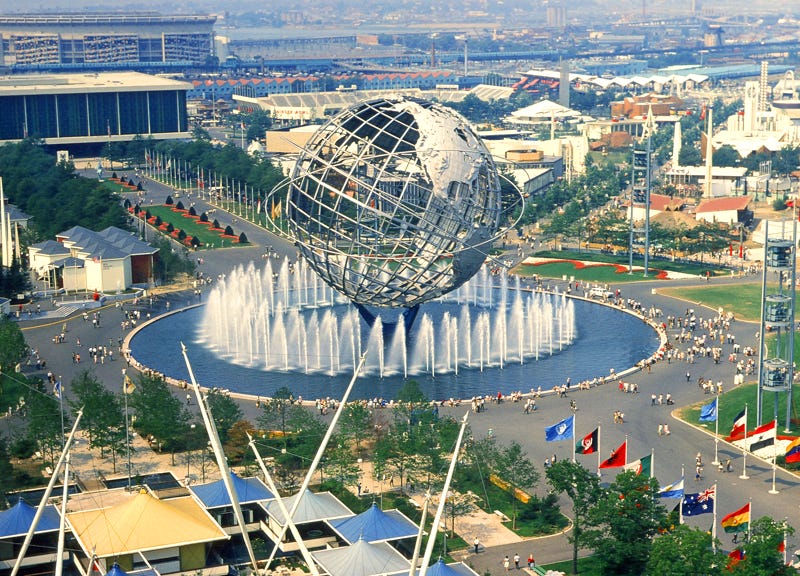
The theme of the fair was “Peace Through Understanding” and it was dedicated to "Man's Achievement on a Shrinking Globe in an Expanding Universe". Eighty nations and dozens of international companies and organizations participated in the fair. The 650 acre fairgrounds were arranged into five areas – Industrial, International, State & Federal, Transportation and Amusement.1 The fair ran for two six-month seasons, April 22 – October 18, 1964, and April 21 – October 17, 1965. Admission price for adults (13 and older) was $2.00 in 1964.2
A Fair Amount of Space
The 1964-65 World’s Fair was conceived and planned during the dawn of the Space Age. Sputnik, the first artificial satellite, had been launched in 1957. NASA had just been formed in 1958 and launched America’s first satellite the same year. In 1961, as the fair was taking shape in the minds of the organizers, Yuri Gagarin and Alan Shepard became the first humans to be launched into space by the Soviet Union and United States, respectively. That same year, John F. Kennedy had just set the nation towards the goal of landing men on the Moon.
The fair opened during the gap between the U. S. Mercury and Gemini flights. The Space Race with the Soviet Union was at the forefront of people’s minds. And, the nascent space industry was well on its way toward transforming their lives in significant ways.
Reflecting the times, the 1964-65 New York World’s Fair contained quite a number of space exhibits and references to spaceflight.
The central symbol of the fair, the Unisphere, contained three references to spaceflight which were hiding in plain sight.
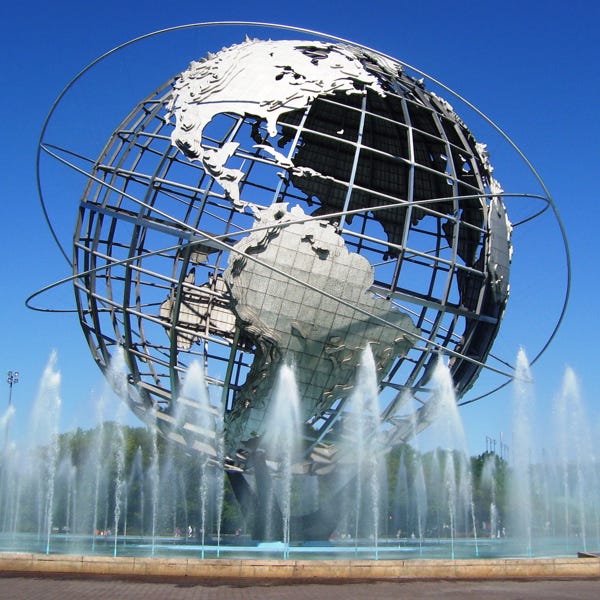
Gilmore Clarke, a park designer and colleague of Robert Moses who led the development of the fair, conceived the Unisphere as a 12-story tall armillary. Enveloping the sphere would be three seemingly free-floating rings which represented the orbits of notable spaceflights that had flown prior to the fair’s opening. The three flights depicted were Yuri Gagarin’s groundbreaking orbit in Vostok 1 in 1961, which ushered in the era of humans in space, John Glenn’s Mercury-Atlas 6 flight, America’s first crewed orbital flight in 1962, and Telstar 1, the first active communications satellite, which launched on top of a Thor-Delta rocket also in 1962.34

Also plainly visible, yet likely overlooked by the average visitor to the fair due to the many visual distractions, were about a half a dozen thoroughfares and landmarks named for space-related objects. If you were one of the fair attendees to study the map included with your souvenir guide book, you would find names such as the Court of the Astronauts, Court of the Sun, Court of the Moon, and the Court of the Universe. If you needed a break from the New York summer heat, you might find relief in the mist of fountains named Planets, Solar, or Lunar.

If you ventured over to the transportation section of the fair, across one of two bridges over the Grand Central Parkway, your eye might be immediately drawn to the 96-foot high green and gray cratered Moon Dome capping one section of the Transportation and Travel pavilion.5 Sixty-five cents (if you held a ten-cents-off coupon) could get you into the round theater where you would be treated to a fifteen-minute film called To the Moon and Beyond projected onto the eighty-foot diameter dome of the Cinerama Spacearium 360.67
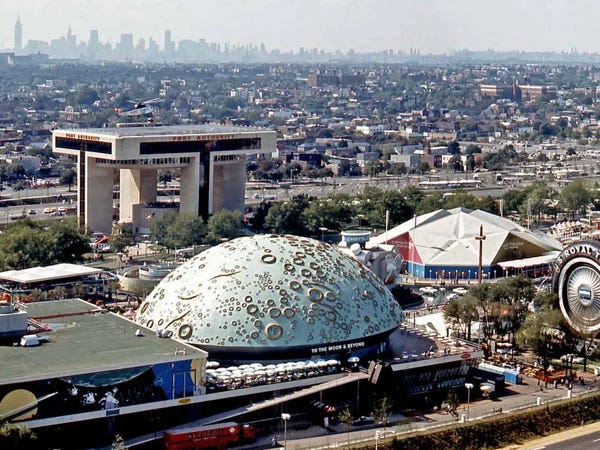
Upon exiting the Spacearium and adjusting your eyes to the bright summer sunlight, you might then notice the toy-like rocketship towering over the Chrysler exhibition space. Chrysler is, of course, well known for building automobiles. Perhaps lesser known among the general public, Chrysler Corporation’s Space Division built the first stages of NASA’s Saturn I series of boosters for the Apollo program.

General Motors’ popular Futurama II pavilion presented visitors a variety of scenes of the predicted future. A common theme throughout the ride was the expansion of Man around the globe and into space. The official guidebook said of the attraction, "A trip to the moon starts the ride taking the visitor past a scale model whose craters and canyons are dotted with manned 'lunar-crawlers' and commuter space ships." GM’s own souvenir brochure informed visitors that “the ‘Moon Rover’ found on the Avenue of Progress is a scale model of the actual apparatus that someday may be exploring the surface of the moon.”
It is worth watching this seven-minute excerpt from a promotional film featuring a young boy as he rides through the Futurama II scenes.

One of the few permanent structures built to endure long after the conclusion of the fair was the New York Hall of Science, the city’s first science center.8 Martin Marietta Corporation donated the Rendezvous in Space exhibit which consisted of a nineteen-minute film by the same name written and directed by Frank Capra and narrated by Danny Thomas.9

After the film ended, the action extended off of the screen and into the cathedral-like space above, where the audience could witness a docking between full size mockups of a winged space taxi and a small nuclear powered space research laboratory nicknamed ‘Know-how’ eighty feet above them.1011
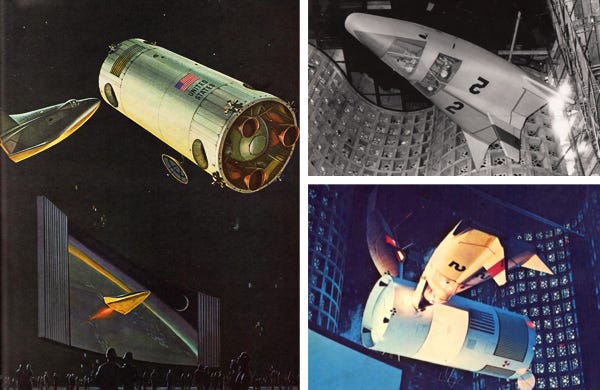
Not to be outdone by the Transportation and Travel pavilion, Kodak’s pavilion had its own stylized moon roof, called the ‘Moondeck’, upon which visitors could stroll along a photo-friendly promenade and get an astronaut’s-eye view of the fair. Inside, visitors could “see and hear a robot astronaut demonstrate how microfilm can store 80 tons of reading matter in less than 90 pounds of film.”12
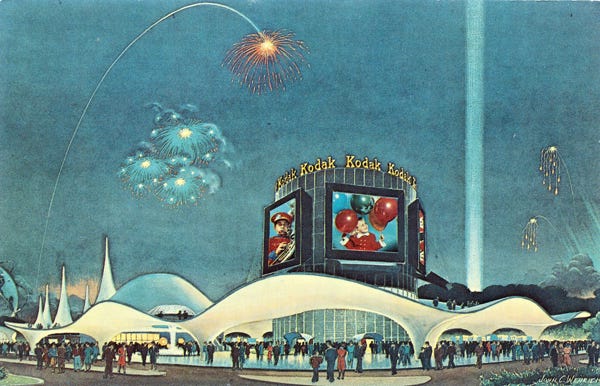
Missouri’s city of St. Louis was home to the McDonnell Aircraft Corporation. At the time of the fair, McDonnell had the distinction of having designed and built the nation’s only two human-piloted spacecraft – the Mercury and Gemini capsules. The State of Missouri pavilion featured both spacecraft among its exhibits. Outside the glass enclosed building stood a replica of the Friendship 7 capsule and launch escape tower, the actual flight having been piloted by John Glenn in 1962. Displayed with the capsule replica was a plaque engraved with the autographs of all the astronauts who had flown in the Mercury program.

Missouri’s Gemini mockup display represented the leading edge of manned spaceflight in the U. S. at the time. Gemini’s first launch occurred as an uncrewed test flight just two weeks prior to the fair’s opening day. The first flight to contain crew, Gemini 3 with Gus Grissom and John Young, would launch in March of 1965, a month before the opening of the fair’s second season. This concept sketch for the display illustrates two of the technology demonstrations that would be necessary for landing men on the Moon in the upcoming Apollo program – extravehicular activity and rendezvous & docking.
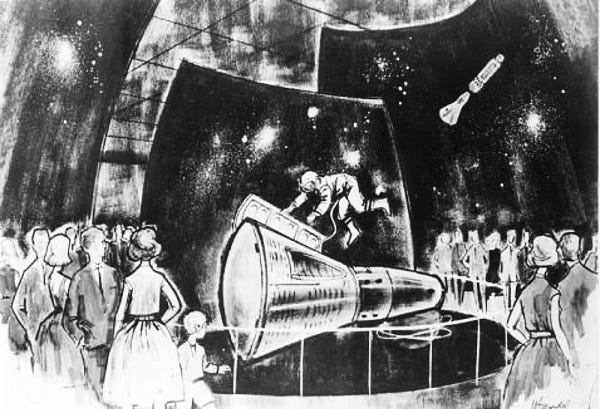
Wait! There’s more!
There’s still a whole other world of space to explore at the fair. NASA, together with the U. S. Department of Defense, sponsored an entire area filled with spacecraft – both real and mockups – designated the U. S. Space Park.
The Space Park, and my own visit to the World’s Fair in 1965, will be the subject of the next Creating Space post. So, stay tuned!

Art News
I am very happy to announce that I will be exhibiting my space-inspired artwork at the U.S. Astronaut Hall of Fame Induction weekend events this year in Cocoa Beach, Florida.
The events are organized by the Astronaut Scholarship Foundation (ASF), a non-profit organization that provides scholarships to the brightest and most talented college students in science, technology, engineering and mathematics.13 I am proud to be able to support the ASF in their educational mission. A portion of my sales proceeds will go directly to the ASF organization.
This year’s celebrations will be held from May 31 through June 1, 2024, marking forty years since the founding of the ASF. It will be my first time exhibiting at an astronaut event since Spacefest X in 2019.

My space-inspired art portfolio can be found at pixel-planet-pictures.com. You can also follow me on Instagram (pixelplanetpics).
Do you know fellow Space Geeks who might enjoy Creating Space? Invite them into this space, too!
Did you miss a post? Catch up here.
If you enjoyed this article please hit the ‘Like’ button and feel free to comment.
All images and text copyright © Dave Ginsberg, unless otherwise noted. All rights reserved.
1964 Official Souvenir Map, nywf64.com
1964 New York World's Fair, https://en.wikipedia.org/w/index.php?title=1964_New_York_World%27s_Fair&oldid=1217370655 (last visited Apr. 21, 2024)
We are the World: the Unisphere in Flushing Meadows-Corona Park, Suzanne Spellen, October 19, 2022
Steel Structure Trivia: The Unisphere Turns 50, Modern Steel Construction, April 25, 2014
Moon Show at the Fair: Film, Viewed on 80-Foot Dome, Offers Dandy, Dizzying Sensations, Bosley Crowther, The New York Times, May 16, 1964
Transportation and Travel, To the Moon and Beyond, T&T Pavilion Newsletter, No. 27, February 19, 1964, nywc64.com
Dedication ceremony for the New York Hall of Science at the 1964 World's Fair, WNYC New York Public Radio, September 1964
Rendezvous in Space. (Complete film from the 1964 World's Fair), via pbatommy on YouTube
Dedication ceremony for the New York Hall of Science at the 1964 World's Fair, WNYC New York Public Radio, September 1964
Kodak at the Fair, Kodak pavilion brochure, 1964-65 New York World’s Fair (Source: worldsfairphotos.com)





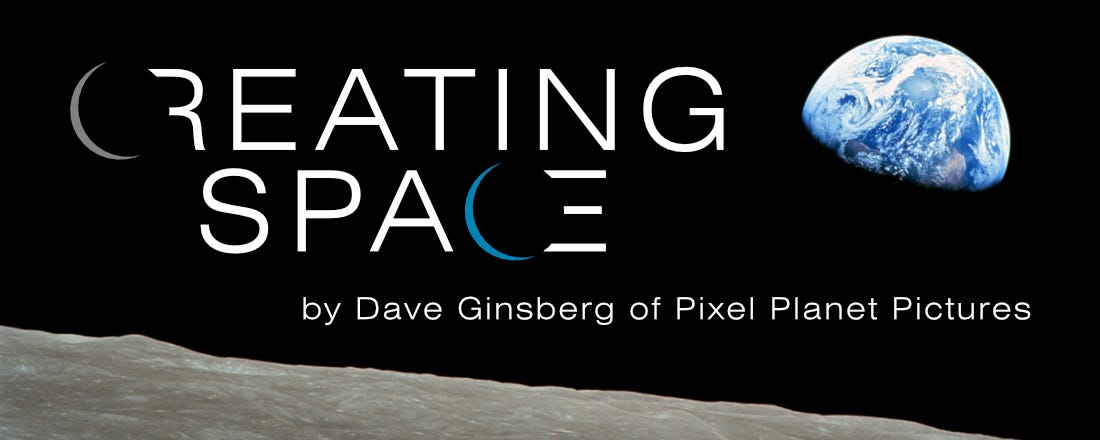

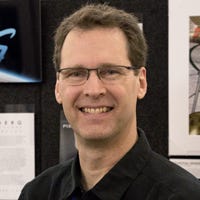


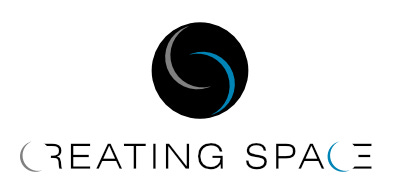
Another nice article on an all inspiring past from my day. I wish I could have been at that fair! Congratulations on your upcoming space event Dave! What an honor to be a part of that great effort!
Excellent post! I would have loved to visit that World Fair. It looks like it would have been fascinating with all of the space-related exhibits. Thanks for such an in-depth account of it.